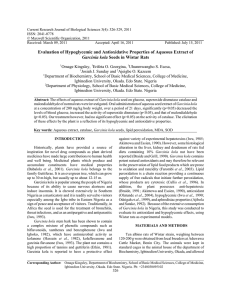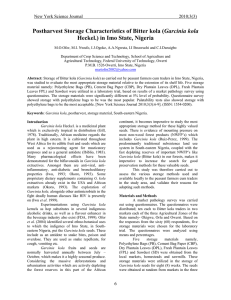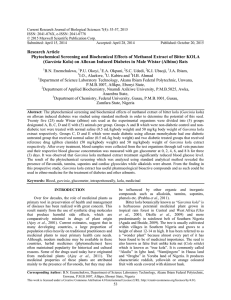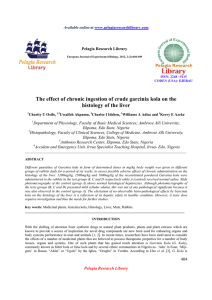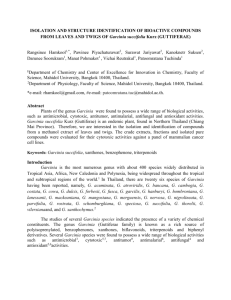Advance Journal of Food Science and Technology 4(1): 9-14, 2012
advertisement
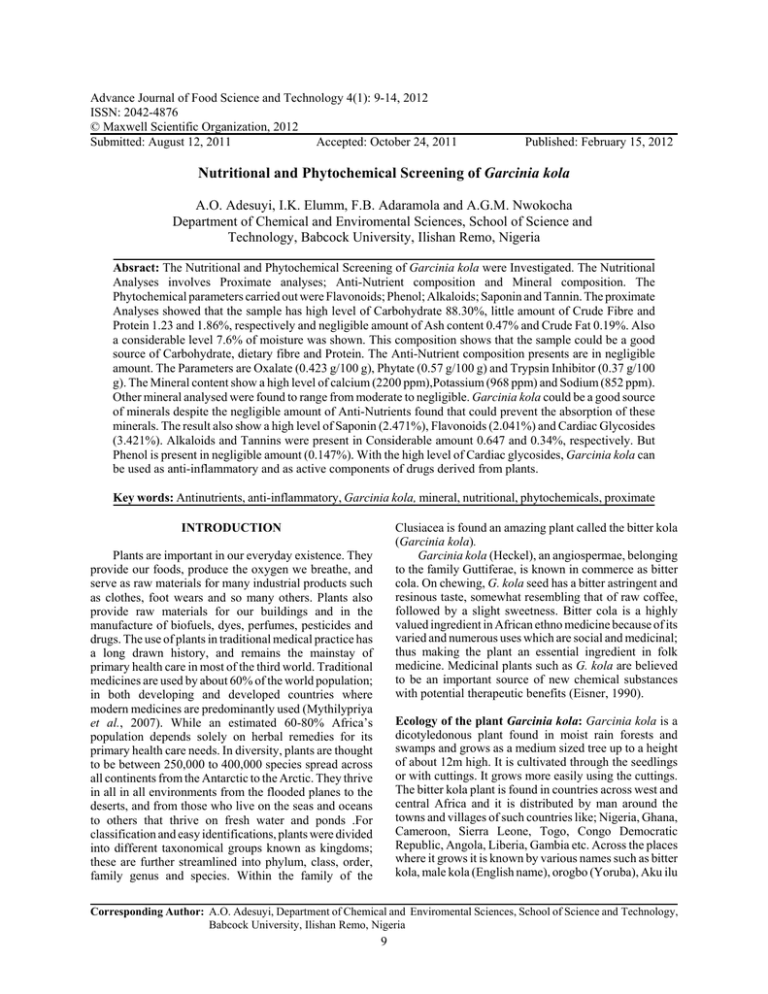
Advance Journal of Food Science and Technology 4(1): 9-14, 2012 ISSN: 2042-4876 © Maxwell Scientific Organization, 2012 Submitted: August 12, 2011 Accepted: October 24, 2011 Published: February 15, 2012 Nutritional and Phytochemical Screening of Garcinia kola A.O. Adesuyi, I.K. Elumm, F.B. Adaramola and A.G.M. Nwokocha Department of Chemical and Enviromental Sciences, School of Science and Technology, Babcock University, Ilishan Remo, Nigeria Absract: The Nutritional and Phytochemical Screening of Garcinia kola were Investigated. The Nutritional Analyses involves Proximate analyses; Anti-Nutrient composition and Mineral composition. The Phytochemical parameters carried out were Flavonoids; Phenol; Alkaloids; Saponin and Tannin. The proximate Analyses showed that the sample has high level of Carbohydrate 88.30%, little amount of Crude Fibre and Protein 1.23 and 1.86%, respectively and negligible amount of Ash content 0.47% and Crude Fat 0.19%. Also a considerable level 7.6% of moisture was shown. This composition shows that the sample could be a good source of Carbohydrate, dietary fibre and Protein. The Anti-Nutrient composition presents are in negligible amount. The Parameters are Oxalate (0.423 g/100 g), Phytate (0.57 g/100 g) and Trypsin Inhibitor (0.37 g/100 g). The Mineral content show a high level of calcium (2200 ppm),Potassium (968 ppm) and Sodium (852 ppm). Other mineral analysed were found to range from moderate to negligible. Garcinia kola could be a good source of minerals despite the negligible amount of Anti-Nutrients found that could prevent the absorption of these minerals. The result also show a high level of Saponin (2.471%), Flavonoids (2.041%) and Cardiac Glycosides (3.421%). Alkaloids and Tannins were present in Considerable amount 0.647 and 0.34%, respectively. But Phenol is present in negligible amount (0.147%). With the high level of Cardiac glycosides, Garcinia kola can be used as anti-inflammatory and as active components of drugs derived from plants. Key words: Antinutrients, anti-inflammatory, Garcinia kola, mineral, nutritional, phytochemicals, proximate INTRODUCTION Clusiacea is found an amazing plant called the bitter kola (Garcinia kola). Garcinia kola (Heckel), an angiospermae, belonging to the family Guttiferae, is known in commerce as bitter cola. On chewing, G. kola seed has a bitter astringent and resinous taste, somewhat resembling that of raw coffee, followed by a slight sweetness. Bitter cola is a highly valued ingredient in African ethno medicine because of its varied and numerous uses which are social and medicinal; thus making the plant an essential ingredient in folk medicine. Medicinal plants such as G. kola are believed to be an important source of new chemical substances with potential therapeutic benefits (Eisner, 1990). Plants are important in our everyday existence. They provide our foods, produce the oxygen we breathe, and serve as raw materials for many industrial products such as clothes, foot wears and so many others. Plants also provide raw materials for our buildings and in the manufacture of biofuels, dyes, perfumes, pesticides and drugs. The use of plants in traditional medical practice has a long drawn history, and remains the mainstay of primary health care in most of the third world. Traditional medicines are used by about 60% of the world population; in both developing and developed countries where modern medicines are predominantly used (Mythilypriya et al., 2007). While an estimated 60-80% Africa’s population depends solely on herbal remedies for its primary health care needs. In diversity, plants are thought to be between 250,000 to 400,000 species spread across all continents from the Antarctic to the Arctic. They thrive in all in all environments from the flooded planes to the deserts, and from those who live on the seas and oceans to others that thrive on fresh water and ponds .For classification and easy identifications, plants were divided into different taxonomical groups known as kingdoms; these are further streamlined into phylum, class, order, family genus and species. Within the family of the Ecology of the plant Garcinia kola: Garcinia kola is a dicotyledonous plant found in moist rain forests and swamps and grows as a medium sized tree up to a height of about 12m high. It is cultivated through the seedlings or with cuttings. It grows more easily using the cuttings. The bitter kola plant is found in countries across west and central Africa and it is distributed by man around the towns and villages of such countries like; Nigeria, Ghana, Cameroon, Sierra Leone, Togo, Congo Democratic Republic, Angola, Liberia, Gambia etc. Across the places where it grows it is known by various names such as bitter kola, male kola (English name), orogbo (Yoruba), Aku ilu Corresponding Author: A.O. Adesuyi, Department of Chemical and Enviromental Sciences, School of Science and Technology, Babcock University, Ilishan Remo, Nigeria 9 Adv. J. Sci. Technol., 4(1): 9-14, 2012 sexual dysfunction in men. The bark is also added into palm wine to improve its potency. In Nigeria, a cold water extract of the roots and bark with salt are administered to cases of Ukwala (bronchial asthma or cough) or agbo (vomiting). (Iwu et al., 1990). The medicinal properties of bitter kola can be classified under (Igbo) and Namijin goro( Hausa). It is also known as false kola mainly due to the absence of stimulants which characterizes the kola nut seeds. It is also known as male kola due to the reported aphrodisiac properties of Garcinia kola. Importance of Garcinia kola: Garcinia kola is regarded as a wonder plant because every part of the plant (bark, leaves, root and wood) have been found to be of medicinal importance. The medicinal importance of bitter kola is based mainly on the phytochemical components of the plant. From its roots to its leaves, the plant is known to contain several phytochemicals noted for their medicinal importance (Iwu et al., 1990). Some of the phytochemicals compounds that have been isolated from Garcinia kola includes, oleoresin, class. Others are tannin, saponins, alkaloids, and cardiac glycoside. Other phytochemicals compounds that have been isolated from bitter kola seeds are; biflavonoids such as kolaflavonone, and 2 hydroxyflavonoids. In addition, two new chromanols; garcioic and garcinal together with tocotrienol have been reportedly isolated from bitter kola (Terashima et al., 2002). The biflavonoids are the more abundant compounds in Garcinia kola, while the kolaflavones are the major components of kolavirons. Other constituents of G. kola include, 1, 3, 8 and 11, respectively benzophenone, Garcinia biflavinones (GB-1, GB-2) and kola flavonone. C C C Purgative Antiparasitic Antimicrobial The antimicrobial nature of this plant has been attributed to the benzophenone and flavonones present in the plant while the anti inflammatory effects of G. kola is believed to result from the inhibition of the cyclo oxygenase enzyme. Proximate analysis: Proximate analysis, also known as Weende analysis is a chemical method of assessing and expressing the nutritional value of a feed, which reports the moisture, ash (minerals), crude fibre, crude fat and crude protein (total nitrogen) present in a fuel as a percentage of dry fuel weight. Carbohydrate (nitrogenfree extract) is determined by difference. The proximate analyses gives the overall nutritional composition of the sample in question, this is briefly complemented by Antinutrient and Mineral composition of the sample. Physiological properties of Garcinia kola: G. kola seed is believed to contain a wide spectrum of organic compounds such as flavonoids which confer on it some antimicrobial and antifungal actions against gram negative and gram positive micro organisms. The biological activities of flavonoids include action against allergies, inflammation, free radicals, and hepatoxins (Terashima et al., 2002). G. kola seed is also used in the treatment of liver disease and diarrhea (Iwu et al., 1990; Braide, 1991). It is also reported to be useful in the treatment of diabetes, bronchitis and throat infections. Traditionally the plant is used as a natural antimicrobial. Other medicinal properties of the plant include its usage in the treatment of skin infections in Liberia and Congo Democratic Republic. The powdered bark of the plant is applied to malignant tumors, cancers etc. the plants latex is taken internally for gonorrhea and externally to seal new wounds and prevent sepsis. In Congo, a bark decoction is taken for female sterility and to ease child birth, the intake being daily till conception is certain and then at half quantity throughout the term. The bark is added to that of Sarcocephalus latifolinus- which has a strong reputation as a strong anti diuretic, in the treatment of urinary decongestion and chronic urethral discharge. In Ivory Coast, a decoction of the bark is taken to induce the expulsion of a dead fetus, while the seed and the bark are taken for stomach pain. In Sierra Leone, the roots and bark are taken as a tonic for Phytochemicals: Phytochemicals are non-nutritive plant chemicals that have protective or disease preventive properties. They are natural bioactive compounds found in plant food, leaves or other parts of plants that interplay with nutrients and dietary fiber to protect them. Recent research demonstrate that they can protect humans against diseases as well as, in risk reduction for a variety of chronic or inflammatory conditions. Some of the well known phytochemicals include; lycopenes found in tomatoes, isoflavones in soy and flavonoids in fruits. Group of polyphenolic compounds in the human diet and are found ubiquitously in plants. There are different types of flavonoids and each appears to have protective effects including anti-inflammatory, anti-oxidant, antiviral, and anti-carcinogenic properties. Flavonoids are generally found in a variety of foods, such as oranges, tangerines, berries, apples and onions. (Middleton et al., 2000). Functions of phytochemicals: Most phytochemicals are known to posses many properties which makes them vital to both plants and animals. Some of these properties are; C 10 Antioxidants: most phytochemicals have antioxidant activity and protect cells against oxidative damage and reduce the risk o developing certain types of cancer. Some phytochemicals with antioxidant activities include: carotenoids (found in fruits), Adv. J. Sci. Technol., 4(1): 9-14, 2012 C C Table 1: Proximate composition of Garcinia kola Parameters (%) Moisture content Crude protein Crude fibre Ash Crude fat Carbohydrate flavonoids (found in fruits, vegetables), polyphenols (tea, grapes). Anti-microbial properties: The phytochemical allicin from garlic has anti-bacterial properties while benzophenone and flavanone found in bitter also posses anti microbial properties. Physiological activities: some phytochemicals bind physiologically to cell walls interfering with the ability of pathogens to bind to cell receptors. Proanthocyanidins are responsible for the antiadhension properties of cranberry. Consumption of cranberries will reduce the risk of urinary tract infections and will improve dental health (Leverin and Mc Matron, 1999). Table 2: Qualitative anti-nutrient screening Parameters Tannin ++ Oxalate ++ Phytate ++ Trypsin inhibitor ++ (+): Trace Amount Present; (+)(+): Abundant Amount Present; (-): No Amount Present Table 3: Quantitative anti-nutrient screening Parameters (g/100g) Tannin 0.342±0.00 Oxalate 0.423±0.00 Phytate 0.570±0.05 Trypsin inhibitor 0.370±0.12 Table 4: Quantitative phytochemical screening Parameters (g/100g) Phenol 0.147±0.00 Saponin 2.471±0.00 Alkaloids 0.647±0.20 Flavonoids 2.041±0.30 Glycosides 3.421±0.00 Objectives of the Research Study: The aims and Objectives of this research work is to: C C 7.2±0.08 1.86±0.15 1.23±0.15 0.47±0.09 0.19±0.32 88.30±0.08 Qualitatively and quantitatively analyze the sample for Nutritional components. Quantitatively carry out the photochemical screening on the sample. MATERIALS AND METHODS Garcinia kola nuts, nutritional and phytochemical analyses: This research work was carried out in April, 2011 at the Department of Chemical and Enviromental Sciences. School of science and technology, Babcock University, Ilishan-Remo, Nigeria. Garcinia kola nuts were harvested from five different trees of the same species. It was then transported in polythene bags to the department of chemical and environmental sciences for identification. Before analysis began, the sample was first chopped into tiny pieces with the use of a stainless steel knife. This was done to increase the surface area needed for the sample to dry quickly. It was then sundried for a week. After drying, the pills were then blown away remaining the seeds of the sample. It was then blended with a blender (the blender was first washed with distilled water and then cleaned with methylated spirit before blending). It was then stored in a fridge until it was used for analysis. chamber until the charred mass stoped emitting smoke. The dish and its content were cooled in a dessicator after which 0.1M HCl was added. The resulting solution was filtered and diluted appropriately. Salts of the metals to be analysed were used to make standards and relevant lamps were fixed for the Analysis. This was done for Mg, Ca, P, Zn, Cu, Fe, Mn and Pb, respectively. The Flame Photometer was used for Na and K in which the Diluents of sample was aspirated into the jenway Digital flame photometer using the filter corresponding to each mineral element. All of these were carried out using the method of analyses described by Oshodi (1992). Phytochemical analyses: Phytochemical analyses includes the Phenol determination, determination of Saponin, determination of Alkaloids and Flavonoids determination. All of these were determined based on methods of analyses described by AOAC (1990). Nutritional property analyses: Proximate analysis of Garcinia kola powder: The Proximate Analyses is a conventional system of analysis that gives the Quantitative as well as Qualitative idea of nutrients present in a particular food sample. Individual nutrients such as amino acids, fatty acids, monosaccharides e.t.c. are not considered. The gross components considered are Moisture content, Ash content, Crude Protein, Crude Fat, Crude Fibre and Carbohydrate (Pearson, 1976; Onyeike and Osuji, 2003). RESULTS AND DISCUSSION The Proximate composition of the Sample is shown in Table 1. The values represent the Mean triplicates ±Standard Deviation. The qualitative Anti-Nutrient Screening of Garcinia kola is shown in Table 2. The quantitative Anti-Nutrient Screening of Garcinia kola is shown in Table 3. Values are Mean Triplicate ± Standard Deviation. The quantitative Phytochemical Screening is shown in Table 4. Values are Mean Triplicate ± Standard Deviation. Table 5 shows the Mineral Composition of Garcinia kola Mineral analyses: 2.0 g of the sample was weighed into a dish and heated on the burnsen burner in a fume 11 Adv. J. Sci. Technol., 4(1): 9-14, 2012 Table 5: Mineral composition Elements Mg Zn Fe Mn Cu Pb P Na K Ca Inhibitor (0.37 g/100 g). Phytate functions as a phosphorous store and a source of cation and a source of myoinositol . Tannins bind and precipitate proteins and other organic compounds including amino acids and alkaloids (McGee, 2004). Oxalates combines with divalent metallic cations such as Calcium and Iron to form crystals of the corresponding oxalates which are then excreted in the urine (Coe et al., 2005).These are considerable amount of Anti-Nutrients the may inhibit the absorption of Minerals. The Phytochemical composition of Garcinia kola indicates that Flavonoids (2.041 g/100 g), Alkaloids (0.647 g/100 g), Glycosides (3.421 g/100 g), Phenols (0.147 g/100 g) and Saponins (2.471 g/100 g) are present in small reasonable quantities. Phytochemicals are biologically active compounds, found in plants in small amounts, which are not established nutrients but which nevertheless contribute significantly to protection against degenerative disease (Dreosti, 2000). (PPM) 153.7±0.00 36.7±0.01 6.4±0.01 6.4±0.00 7.8±0.00 0.3±0.01 16.76±0.00 852±0.71 968±0.72 2200±0.00 Carbohydrate: Carbohydrates or Saccharrides are the most abundant biological molecules. They are said to be chemically simpler nucleotides or amino acid because they contain just three elements namely Carbon, Hydrogen and Oxygen. They play important roles in the body as sources of energy as well as structural materials (Voet et al., 2008). The result of this research has confirmed that Garcinia kola has a higher percentage of carbohydrate (88.30%) than Sorghum bicolour. L stem flour (44.52%) as reported by Adetuyi and Akpambang (2005) and can be used as a source of Carbohydrate. They also provide readily accessible fuel for physical performance and regulate nerve tissue (Whitney and Rolfes, 2005). Flavonoids: have protective effects including antiinflammatory, anti-oxidant, antiviral, and anticarcinogenic properties. They are generally found in a variety of foods, such as oranges, tangerines, berries, apples and onions (Middleton et al., 2000). Garcinia kola can be a good dietary source of flavonoids. Moisture content: The moisture content of the sample, which is the second highest value (7.6%) indicates the presence of moisture in considerable amount. Too much of moisture in any food sample can make the sample viable for Microorganism growth. This accounts for most of the biochemical and physiological reactions in the plant (Guisseppe and Baratta, 2000). Alkaloids: are heterogeneous group of naturally occurring compounds found in the leaves, bark, roots or seeds of plants. Some alkaloids stimulate the nervous systems; others can cause paralysis, elevate blood pressure or lower it. Certain alkaloids act as pain relievers, others act as tranquilizers. Others have also been noted to contain antimicrobial properties. Proper extraction and use of alkaloids from Garcinia kola can be relevant in Medicine in manufacture of vaccines to prevent diseases. Protein: Proteins, another class of food often times refered to as the ‘Nitrogen-containing natural product’, has been proved to be essential for the survival of human beings and Animals (Voet et al., 2008). Proteins have also been detected to be composed of building blocks called Amino Acids. The sample shows a considerable amount of proteins (1.86%) even though its low compaired to the protein level in some commonly consumed oil seed in Nigeria like rapeseed (25%) and Sunflower (28.7%) as reported by Jackson (2000). Garcinia kola can still be used as a source of Protein. The other gross components are present in minute quantities. Crude fibre content (1.23%) shows that the sample contains little amount of Cellulose, Hemicellulose and Lignin. The qualitative and quantitative Anti-Nutrient composition shows that Garcinia kola has in abundance some anti-nutrients like Tannin (0.34 g/100 g), Phytate (0.57 g/100 g), Oxalate (0.423 g/100 g) and Trypsin Phenols: is a crystalline aromatic organic compound. It is a constituent of coal tar. Dilute solutions of phenol are useful antiseptics, but strong solutions of phenols are caustic and scarring to tissues. Phenols are widely used in the manufacture of resins, plastics, insecticides, explosives, dyes and detergents and as raw materials for the productions of medicinal drugs such as aspirin (Michael, 2008). Garcinia kola can then be of economic Importance in these aforementioned areas. The Mineral content of Garcinia kola show a great deal of mineral composition. Its a proved fact that the level of sodium in Nigerian food plant is much lesser than that of potassium (Rimbach et al., 2000) and this is confirmed by the values of the minerals in question, Sodium (852 ppm) and Potassium (968 ppm). It’s also been established that Potassium is the most abundant Mineral in Nigerian Agricultural product (Oshodi 12 Adv. J. Sci. Technol., 4(1): 9-14, 2012 Fagbemi, T.N., 2004. Processing effect on the chemical composition and functional properties of three tropical seeds: Breadnut (Antrocarpus attilis), Cashewnut (Anacardium cocidentails) and Fluted pumkin(Te1faria occidentails). Ph.D. Thesis, Chemistry Department Federal University of Technology, Akure, Ondo State, Nigeria. Guisseppe, R. and T.M. Baratta, 2000. Antioxidant activity of selected essential oil components in two lipid model systems. Afr. J. Biotechnol., 69(2): 167-174. Iwu, M.M., O.A. Igboko, C.O. Okunji and M.S. Tempesta, 1990. Antidiabetic and aldose reductase activities of Biflavanones of Garcinia kola. J. Pharm. Pharmacol. 42: 290-292. Jackson, A.A., 2000. Advances in Experimental Medicine and Biology. Plenum Press, New York. Leverin, G. and H. Mc Matron, 1999. Alkaloids and Glycosides. Clin. Microbiol. Rev., 11: 156-250. McGee, H., 2004. On Food and Cooking: The Scienc and Love of the Kitchen. Scribner, New York, pp: 174. Michael, C.H., 2008. Western poison-Oak; Toxicodendron diversilobum. 1st Edn., Global Twitcher. Nicklas Stromberg, pp: 49. Middleton, E. Jr., C. Kandaswani and T.C. Theoharides, 2000. The effects of plant flavonoids on mammalian cells, implication for inflammation, heart disease and cancer. Pharmacology, 52: 673-751. Mythilypriya, R., P. Shanthi and P. Sachdanandam, 2007. Oral acute and subacute toxicity studies with Kalpaamruthaa, a modified indigenous preparation, on rats. J. Health Sci., 53(4): 351-358. Nelson, D.L. and M.M. Cox, 2008. Lehninger Principles of Biochemistry. 5th Edn., W.H. Freeman & Company. Madison Avenue, New York, pp: 343. Onyeike, E.N. and J.O. Osuji, 2003. Research Techniques in Biological and Chemicals Sciences. Springfield Publishers Limited. Owerri, Nigeria. pp: 403. Oshodi, A.A., 1992. Proximate consumption, nutritionally valuable minerals and functional properties of adenopus breviflorus benth seed and protein concentrate. Food Chem. 45: 79-83. Oshodi, A.A., H.N. Oqungbenle and M.O. Olahmeji, 1999. Chemical composition, nutritionally valuable minerals and functional properties of benniseed (Sesamum radiatum), pearl millet (Pennisetum typoides) and quinoa (Chenopodium quinoa) flours. Int. J. Food Sci. Nutr., 50: 325-331. Pearson, D., 1976. The Chemical Analysis of Foods. 17th Edn., Churchill Livingstone, London, pp: 3-4. Rimbach, G., T. Guo, Q. Akiyama and S. Matsugo, 2000. Inhibitory effect of fermented papaya prepairation on hydroxyl rahcal generation from methylguanihne. Anticancer Res., 20: 2907-2914. Terashima, K., Y. Takaya and M. Niwa, 2002. Powerful antioxidative agents based on garcinoic acid from Garcinia kola. Bioorganic Med. Chem., 10(5): 1619-1625. et al., 1999). This is also confirmed by the values of the minerals except for Calcium (2200 ppm) which is the highest. The level of Calcium is relatively high compared to the level reported for the African yam bean varieties (70-128 ppm) by Fagbemi (2004). Magnesium (153.7 ppm) is also present. These elements support human biochemical processes by serving structural and functional roles as electrolytes (Nelson and Cox, 2008). Sodium and Potassium are necessary to maintain osmotic balance in the body as well as the pH. Calcium (2200 ppm), is needed for the formation of bones and it supports the synthesis and function of blood cells. Iron is present in considerable amount (6.4 ppm) and its necessary in formation of haemoglobin and normal functioning of the central nervous system. Phosphorus, an mineral in bone formation is also present (16.76 ppm). The other Micro minerals like Manganense, Copper and Zinc are also present and they play important roles in metabolic activities Garcinia kola can be a good source of these minerals. CONCLUSION AND RECOMMENDATIONS From the research, its been established through the Nutritional screening that Garcinia kola can be used as a good source of Carbohydrate and Protein. Also a good source of Minerals necessary for metabolic activities in the body despite the trace amount of Anti-nutrients.The Phytochemical composition also shows that Garcinia kola can be useful in the Pharmaceutical and Medical science to make vaccine and supplements that can prevent diseases. It can be useful also in Various manufacturing industries as raw material. REFERENCES Adetuyi, A.O. and O.E. Akpambang, 2005. The nutritional value of sorgum bicolorl stem flour used for infusion drinks in Nigeria. Pak. J. Sci. Ind. Res., 49: 276-276. Association of Official Analytical Chemists (AOAC), 1990. Official Methods of Analysis. 16th Edn., Washington, DC, 1: 600-792. Braide, V.P., 1991. Antihepatotoxic Biochemical effects of kola viron, a Biflavonoid of Garcinia kola seeds. Phytotherapy Res., 5: 35-37. Coe, F.L., A., Evan, and E. Worcester, 2005. kidney stone disease. J. Clin. Investigation, 115(10): 2598-2608. Dreosti, I.E., 2000. Recommended dietary intake levels for phytochemicals: Feasible or Fanciful? Asia Pacific J. Clin. Nutr. 9: 119-122. Eisner, T., 1990. Chemical prospecting. A Call for Action. In: Borman, F.H. and S.R. Keller, (Eds.), Ecology, Economics and Ethics: The Broken Circle. Yale University Press, New Haven, CT, pp: 105-110. 13 Adv. J. Sci. Technol., 4(1): 9-14, 2012 Voet, D.J, J.G. Voet and C.W. Pratt, 2008. The Principles of Biochemistry. 3rd Edn., John Wiley & Sons 111 River Street, Hoboken, pp: 74-219. Whitney, E.N. and S.R. Rolfes, 2005. Understanding Nutrition. 10th Edn., Thomson/Wadsworth Publishing Company, Belmont, CA, pp: 132-137. 14
